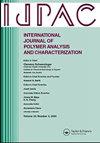Synthesis of PPy/CeO2 nanocomposites for supercapacitor application
IF 1.6
4区 工程技术
Q4 POLYMER SCIENCE
International Journal of Polymer Analysis and Characterization
Pub Date : 2024-12-21
DOI:10.1080/1023666X.2024.2440504
引用次数: 0
Abstract
Polypyrrole is synthesized by the chemical oxidation polymerization method with K2Cr2O7 as an oxidant, and H2SO4 as a dopant. This method was effective, as indicated by the large yield of PPy/CeO2 (Polypyrrole/Cerium oxide) nanocomposite produced during synthesis. FT-IR spectra demonstrated the chemical interactions between PPy and CeO2 nanoparticles. The prepared polypyrrole and polypyrrole nanocomposites were studied through structural and optical studies using XRD and UV-Vis analysis. Average crystalline sizes of PPy and PPy/CeO2 nanocomposites are found to be 10.4 and 8.84 nm. The electrical conductivity of polypyrrole is lower than that of polypyrrole nanocomposite, which could be attributed to the inadequate hydration water as well as the surface conductivity carried through the thin polymer layer. In comparison to n-CeO2PPy (433 F/g) and PPy (226 F/g) at the scan rate of 100 mV/s, the electrochemical measurements demonstrated that the fabricated electrode of n-CeO2PPy is a suitable electrode material and can improve the capacitive performance of supercapacitors due to its high capacitive value (433 F/g). Electrochemical studies showed that CeO2PPy nanocomposites (n-CeO2PPy) have improved specific capacitance and reduced impedance compared to PPy. These improvements can be attributed to the synergistic effects between PPy and CeO2PPy nanocomposites, which facilitate efficient charge transport and ion diffusion.
超级电容器用PPy/CeO2纳米复合材料的合成
以K2Cr2O7为氧化剂,H2SO4为掺杂剂,采用化学氧化聚合法制备聚吡咯。该方法是有效的,制备的PPy/CeO2(聚吡咯/氧化铈)纳米复合材料收率高。FT-IR光谱显示了聚吡啶和CeO2纳米颗粒之间的化学相互作用。采用XRD和UV-Vis分析对制备的聚吡咯和聚吡咯纳米复合材料进行了结构和光学研究。PPy和PPy/CeO2纳米复合材料的平均晶粒尺寸分别为10.4和8.84 nm。聚吡咯的电导率低于聚吡咯纳米复合材料,这可能是由于水化水不足以及通过薄聚合物层携带的表面电导率所致。与扫描速率为100 mV/s的n-CeO2PPy (433 F/g)和PPy (226 F/g)相比,电化学测量结果表明,制备的n-CeO2PPy电极具有较高的电容值(433 F/g),是一种合适的电极材料,可以提高超级电容器的电容性能。电化学研究表明,与PPy相比,CeO2PPy纳米复合材料(n-CeO2PPy)具有更高的比电容和更低的阻抗。这些改进可归因于PPy和CeO2PPy纳米复合材料之间的协同作用,促进了有效的电荷传输和离子扩散。
本文章由计算机程序翻译,如有差异,请以英文原文为准。
求助全文
约1分钟内获得全文
求助全文
来源期刊
CiteScore
3.50
自引率
5.30%
发文量
37
审稿时长
1.6 months
期刊介绍:
The scope of the journal is to publish original contributions and reviews on studies, methodologies, instrumentation, and applications involving the analysis and characterization of polymers and polymeric-based materials, including synthetic polymers, blends, composites, fibers, coatings, supramolecular structures, polysaccharides, and biopolymers. The Journal will accept papers and review articles on the following topics and research areas involving fundamental and applied studies of polymer analysis and characterization:
Characterization and analysis of new and existing polymers and polymeric-based materials.
Design and evaluation of analytical instrumentation and physical testing equipment.
Determination of molecular weight, size, conformation, branching, cross-linking, chemical structure, and sequence distribution.
Using separation, spectroscopic, and scattering techniques.
Surface characterization of polymeric materials.
Measurement of solution and bulk properties and behavior of polymers.
Studies involving structure-property-processing relationships, and polymer aging.
Analysis of oligomeric materials.
Analysis of polymer additives and decomposition products.

 求助内容:
求助内容: 应助结果提醒方式:
应助结果提醒方式:


